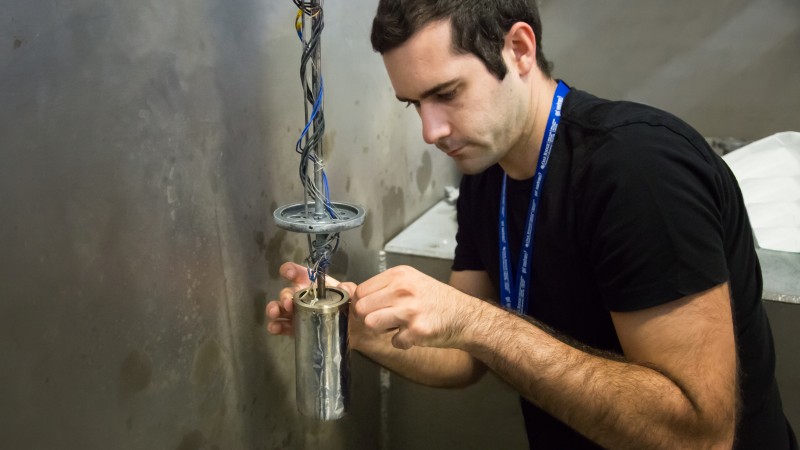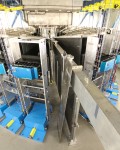A team of researchers from the University of South Carolina is using neutrons to develop more durable and efficient materials called waste forms for safely storing hazardous substances.
The USC team recently visited the Department of Energy’s Oak Ridge National Laboratory to study salt-inclusion materials (SIMs) that contain internal silicate channels with the capacity to safely immobilize nuclear waste. The researchers hope to obtain valuable insights into the materials’ properties using resources at ORNL’s Spallation Neutron Source such as the POWGEN instrument, SNS beamline 11A.
“We are studying SIMs with the intent to create new materials that more efficiently and safely sequester nuclear waste elements like technetium,” said principal investigator Hans-Conrad zur Loye. “This is a long-term process, and we hope to develop the fundamental chemistry needed to design these waste forms over the next several years.”
Waste form materials act as a sort of crystalline “bag” to contain radioactive elements as they decay over time. The researchers aim to design a tailored waste form to encapsulate radioactive isotopes and provide additional safeguards. For example, if water leaks into the containers, the new waste form would not dissolve.
The researchers are studying ion-exchange reactions, the process by which non-radioactive salts are replaced with radionuclides for long-term storage in SIMs. The team had previously used x-rays to analyze the reactions’ aftereffects and now plans to take advantage of neutrons’ penetrating and nondestructive nature to reveal structural changes in real time. This knowledge will help identify which properties are needed for a material to effectively immobilize nuclear waste.
“We know what we start with and what we end up with, but we don’t yet know what transpires in the middle,” zur Loye said. “The ability to see what happens during the process is unique to neutrons.”
This research is conducted as part of the Center for Hierarchical Waste Form Materials (CHWM), a DOE Energy Frontier Research Center. CHWM’s goal is to develop new materials capable of storing a higher concentration of nuclear waste without allowing radioactive content to seep into the surrounding environment. One way to achieve this balance is through hierarchical materials like SIMs, which consist of smaller structures contained within larger ones. Researchers at the center study different variations of these substances and model new mediums for nuclear waste storage.
“Our goal is to make new nuclear waste storage materials to safely sequester radionuclides so they do not enter the water supply or the atmosphere,” zur Loye said. “If we can design a material that provides an additional margin of safety, we might be able to provide a safe solution for thousands of years to come.”
SNS is a DOE Office of Science User Facility. UT-Battelle manages ORNL for the DOE Office of Science. The Office of Science is the single largest supporter of basic research in the physical sciences in the United States and is working to address some of the most pressing challenges of our time. For more information, please visit http://science.energy.gov/.—by Elizabeth Rosenthal





